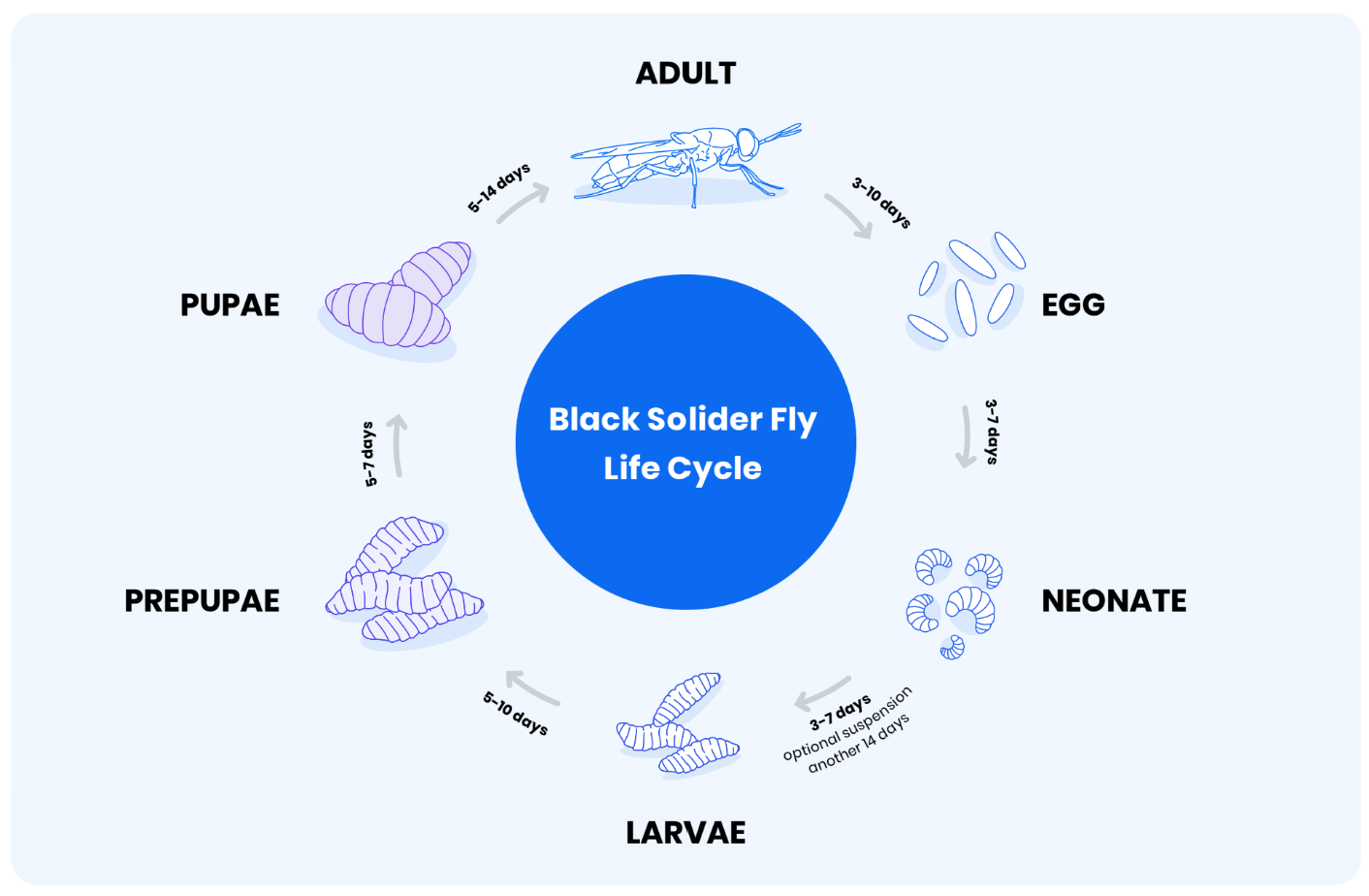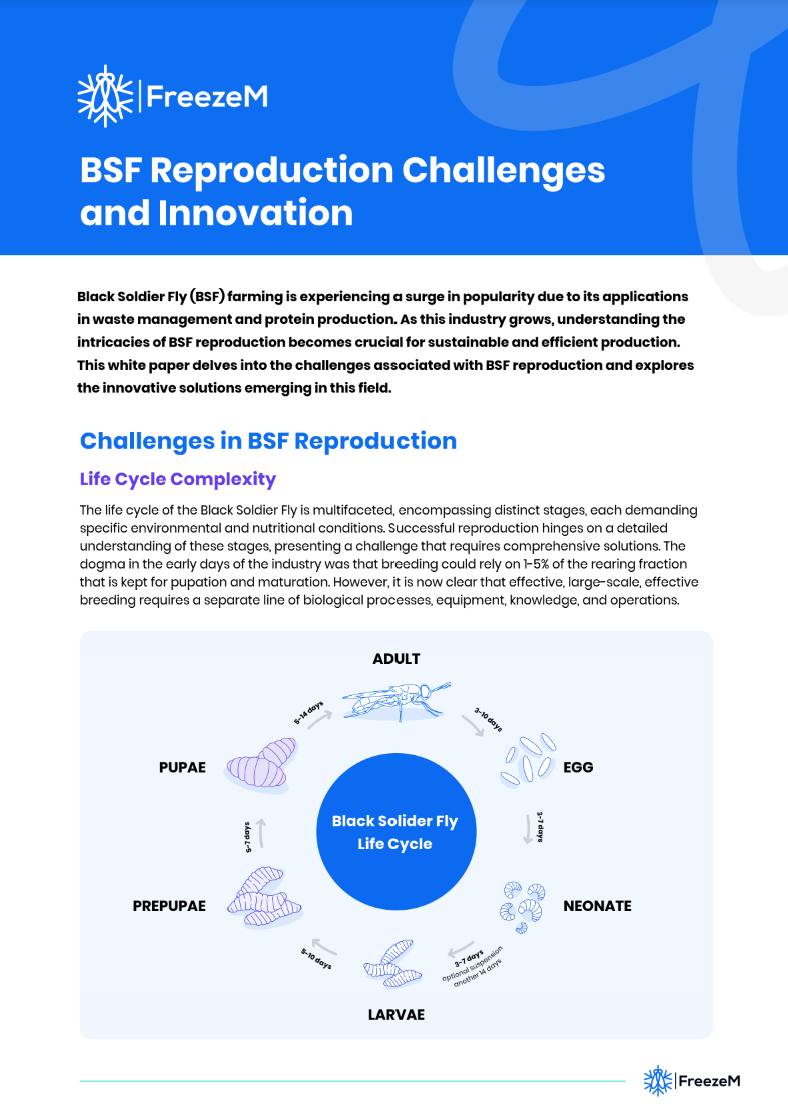BSF Reproduction: Challenges and Innovation
Black Soldier Fly (BSF) farming is experiencing a surge in popularity due to its applications in waste management and protein production. As this industry grows, understanding the intricacies of BSF reproduction becomes crucial for sustainable and efficient production. This white paper delves into the challenges associated with BSF eproduction and explores the innovative solutions emerging in this field.
What you’ll learn:
Challenges in BSF Reproduction
- Life Cycle Complexity
- Environmental Factors
- Nutritional requirements
- Genetics and Colony Health
- Oviposition, Hatching, and Dosing of Neonates
Innovation in BSF Reproduction
- Breeding Equipment: Cages and Climate Control
- Genetics
- Breeding Supply
Conclusion
Challenges in BSF Reproduction
Life Cycle Complexity
The life cycle of the Black Soldier Fly is multifaceted, encompassing distinct stages, each demanding specific environmental and nutritional conditions. Successful reproduction hinges on a detailed understanding of these stages, presenting a challenge that requires comprehensive solutions. The dogma in the early days of the industry was that breeding could rely on 1-5% of the rearing fraction that is kept for pupation and maturation. However, it is now clear that effective, large-scale, effective breeding requires a separate line of biological processes, equipment, knowledge, and operations.
Environmental Factors
BSF reproduction is significantly influenced by environmental factors¹, including temperature, humidity, and lighting conditions. Maintaining optimal conditions becomes increasingly challenging in largescale farming operations. Innovations are necessary to tackle these challenges and ensure consistent reproductive success. The production and efficient usage of Black Soldier Fly Larvae (BSFL) depend on several key factors. These include an optimal rearing temperature of 26-28°C, a relative humidity range of 60-70%, a substrate moisture content of 52-70%, and an optimal light intensity of 135-200 μmol/m^2. Achieving and maintaining these specific conditions is vital for maximizing the productivity and efficiency of BSFL in farming operations. Amazingly, it’s important to note that if these optimal environmental conditions are not carefully maintained, reproduction yield can drop significantly.ons.

Nutritional Requirements
While BSF rearing can be performed on variable and sometimes sub-optimal diets, rearing for breeding should be performed with a carefully designed diet that supports maximal fertility and fecundity. The nutritional values for rearing are relatively mapped, but this is not the case for optimal reproduction. In addition, whereas the adult flies do not eat, they should be supplied with water and sometimes some additives like sugar to increase their viability and lifespan. Additional questions remain unanswered about essential macro and micronutrients that are essential for efficient reproduction.
Genetics and Colony Health
Maintaining a healthy colony over extended periods necessitates vigilant oversight of genetic diversity and overall health, including preventing the transmission of pathogens and diseases. In-breeding among BSF colonies is prevalent, and while it may temporarily enhance larvae performance on specific substrates, it can lead to unforeseen eclines in egg yield or even colony collapse in the long term. Moreover, the warm, humid conditions maintained year-round in indoor BSF breeding facilities can foster the proliferation of pathogenic microorganisms or mites, potentially jeopardizing colony performance. Therefore, continuous monitoring and preservation of BSF genetic diversity and health are essential to ensure consistent, high-quality breeding performance.
Optimizing Oviposition, Hatching, and Dosing of Neonates
Directing oviposition to the desired location is a challenge in large-scale BSF breeding operations. BSF females can choose to lay their eggs in various places within a cage (e.g., on the walls, corners, dead flies, etc.) This can result in a significant loss of precious egg yield (up to dozens of percentages).
Although some improvised attractants are employed to guide oviposition, many are internally concocted through fermentation or similar biological methods. However, these solutions often lack consistency and stability, resulting in substantial losses when implemented on a larger scale. Due to natural fluctuation, BSF egg yield is not consistent, requiring breeding colonies to produce between 1.5 to 3 times their required amount to ensure an adequate supply for rearing.
In addition, since eggs are very sensitive, improper incubation often leads to low hatching performance in a non-synchronized manner, causing additional inconsistencies. Once hatched, neonates have to be encountered with feed to start their rapid growth. This should be done in a proper larvae-to-feed ratio so feed conversion rate (FCR) will be optimized. Altogether, inaccurate oviposition, hatching, and dosing of neonates can result in a dramatic loss in breeding efficiency and, thus, overall production performance..
Innovation in BSF Reproduction
Breeding Equipment: Cages and Climate Control
While rearing and processing solutions with validated performance are already available on the market, breeding systems are lagging behind and only starting to emerge. Currently, there are a handful of breeding equipment providers offering cage systems, lighting, ventilation, climate systems, and counting machines. However, as the BSF farming market matures, more innovative products are expected to emerge in this field.

Genetics
Genetic innovation in BSF can be divided into three main categories:
1. Tools and infrastructure – the BSF genome was already sequenced with high coverage by several groups, and the genetic data is available for academic and commercial applications. Such infrastructure is crucial for the advancement of basic research and to support breeding programs.
2. Classical breeding programs – Several BSF companies are focusing on classical breeding programs to enhance selected natural traits. Their goal is to develop their own strains in order to maintain a competitive advantage in the market. These breeding programs are supported by biological or genetic markers and powerful selective pressures aimed at identifying and nurturing subpopulations with naturally occurring benefits. While this approach is considered by many as very promising, no new line created by classical breeding has yet to be introduced to the market. In addition, due to genetic drifts and other instability issues, resolving the ability to maintain various lines of improved BSF is still necessary.
3. Targeted genomics – A different approach for creating enhanced lines of BSF is based on targeted manipulation of the genome by means of gene editing (e.g. CRISPR-Cas9) or the generation of transgenic BSF lines embedding new properties from other organisms. While targeted genomics is advancing rapidly in the BSF industry, its industrial-scale application depends on regulation and customer acceptance.overall production performance.
Breeding Supply
Parallel to the above innovations, different approaches to the breeding supply chain are being developed. While first-generation BSF companies took the vertically integrated approach, meaning all parts of the supply chain (from breeding to processing) are performed under one roof, more agile approaches of decoupled production models are being developed.
In these approaches, breeding is separated from rearing and processing and provided to insect farms by external providers, similar to seeds in agriculture or piglets in the swine industry. The breeding supply chain is supported by innovative solutions such as PauseM®. This allows for the complete outsourcing of breeding or the minimization of risks associated with relying solely on in-house breeding by adopting a hybrid supply approach, blending outsourced and in-house breeding strategies.
These new supply chain models are becoming more attractive to new market entrants, saving them significant Capex investment, ramp-up time, and operation complexity.
Conclusion
As the demand for sustainable waste management and alternative protein production continues to grow, overcoming challenges in BSF reproduction becomes paramount. This comprehensive review sheds light on the current challenges and innovative approaches in the field, emphasizing the necessity for ongoing research and development. The success and scalability of BSF farming practices depend on a continuous commitment to addressing challenges and embracing advancements in reproduction technologies.
FreezeM
FreezeM stands at the forefront of advancing Black Soldier Fly (BSF) reproduction, offering a unique blend of cutting-edge technology and strategic assistance to businesses navigating the dynamic insect-based protein industry. One of FreezeM’s pioneering solutions is the introduction of PauseM® patented suspended BSF neonates, a breakthrough that reshapes farming and waste management processes. This technology not only optimizes control and efficiency in BSF reproduction but also streamlines the overall approach. FreezeM is actively contributing to the evolution of insect-based protein production by incorporating state-of-the-art techniques to address the increasing demand for sustainable protein sources while overcoming challenges in traditional farming methods.
In alignment with Environmental, Social, and Governance (ESG) initiatives, FreezeM places a strong emphasis on sustainability. The company actively participates in waste reduction and sustainable agriculture through its BSF reproduction solutions, supporting customers in their commitment to ecofriendly practices. FreezeM’s dedicated team plays a pivotal role in easing the onboarding process for new market entrants, facilitating a smooth entry into the insect-based protein sector. For large enterprises, FreezeM provides valuable support in efficiently expanding BSF operations, and navigating potential challenges associated with cost and time constraints. Recognizing the diverse objectives of businesses, FreezeM offers tailor-made, ready-to-use solutions, ensuring that the implementation of BSF reproduction aligns seamlessly with the specific goals and requirements of each customer.
1. https://www.frontiersin.org/articles/10.3389/fsufs.2021.701797/full
2. https://www.researchgate.net/publication/330293055_Nutritional_requirements_of_BSF_larvae


